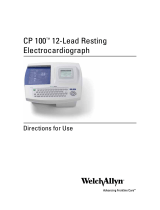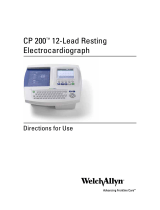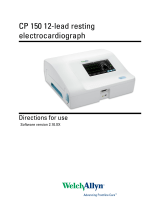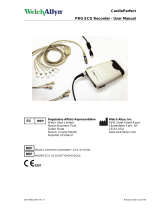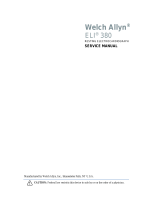Page is loading ...

CP 50™and CP 50 Plus™
12-lead resting
electrocardiograph
Service manual

ii Welch Allyn CP 50 and CP 50 Plus 12-lead resting electrocardiograph
Copyright 2013 Welch Allyn. All rights are reserved. To support the intended use of the product described
in this publication, the purchaser of the product is permitted to copy this publication, for internal
distribution only, from the media provided by Welch Allyn. No other use, reproduction, or distribution of
the publication, or any part of it, is permitted without written permission from Welch Allyn. All rights are
reserved.
Caution Federal US law restricts sale of the device identified in this manual to, or on the order of, a
licensed physician.
Welch Allyn assumes no responsibility for any injury, or for any illegal or improper use of the product, that
may result from failure to use this product in accordance with the instructions, cautions, warnings, or
indications for use published in this manual.
Welch Allyn is a registered trademark of Welch Allyn, Inc. CP 50 and CP 50 Plus are trademarks of Welch
Allyn, Inc.
Software in this product is copyright Welch Allyn or its vendors. All rights are reserved. The software is
protected by United States of America copyright laws and international treaty provisions applicable
worldwide. Under such laws, the licensee is entitled to use the copy of the software incorporated within
this instrument as intended in the operation of the product in which it is embedded. The software may not
be copied, decompiled, reverse-engineered, disassembled or otherwise reduced to human-perceivable
form. This is not a sale of the software or any copy of the software; all right, title and ownership of the
software remains with Welch Allyn or its vendors.
Caution Changes or modifications not expressly approved by Welch Allyn could void the purchaser’s
authority to operate the equipment.
For information about any Welch Allyn product, contact Welch Allyn Technical Support
(www.welchallyn.com/support) or visit www.welchallyn.com/about/company/locations.htm.
Manual Material No. 105488 Ver. F
Welch Allyn Limited
Navan Business Park
Dublin Road
Navan, County Meath
Republic of Ireland
Tel.: +353 46 90 67700
Fax: +353 46 90 67755
Welch Allyn, Inc.
4341 State Street Road
Skaneateles Falls, NY 13153-0220
USA

Service manual Contents iii
Contents
1 - Safety summary .........................................1
Purpose of this manual .............................................1
Service policy ....................................................1
Symbols ........................................................2
General Warnings .................................................2
Warnings related to the environment...............................2
Warnings related to accessories and other equipment .................3
Warnings related to using the electrocardiograph .....................4
General Cautions .................................................4
Electrostatic discharge (ESD) ........................................6
2 - Export and import process .................................7
3 - Update process ..........................................9
4 - Upgrade process ........................................11
5 - Performing a full-functional test ...........................13
6 - Troubleshooting ........................................15

iv Contents Welch Allyn CP 50 and CP 50 Plus 12-lead resting electrocardiograph

1
1
Safety summary
All service technicians of the electrocardiograph must read this safety summary and all
warning and caution statements in the manual.
Any internal part(s) replacement or assembly and reassembly must be performed by
qualified service personnel with an understanding of technical English. When a service
part is ordered, verbal confirmation of these qualifications will be recorded before the
sale.
Purpose of this manual
The purpose of this manual is to assist with some common troubleshooting scenarios you
may encounter and to explain the export and import, update, and upgrade process.
Service policy
All repairs on products under warranty must be performed by Welch Allyn or by a service
provider authorized by Welch Allyn. Unauthorized repairs will void the warranty. In
addition, whether or not covered under warranty, any product repair should be performed
exclusively by Welch Allyn or by a service provider that has been authorized by Welch
Allyn.
If the product fails to function properly—or if you need assistance, service, or spare
parts—contact the nearest Welch Allyn Technical Support Center.
Before contacting Welch Allyn, try to duplicate the problem, and check all accessories to
ensure that they are not causing the problem. When calling, please be prepared to
provide:
• Product name, model number, and serial number of your product.
• Complete description of the problem.
• Complete name, address and phone number of your facility.
• For out-of-warranty repairs or spare parts orders, a purchase order (or credit card)
number.
• For parts orders, the required spare or replacement part numbers.
If your product requires warranty, extended warranty, or non-warranty repair service,
please call first the nearest Welch Allyn Technical Support Center. A representative will
assist you troubleshooting the problem and will make every effort to solve it over the
phone, avoiding potential unnecessary return of your product.
In case a return cannot be avoided, the representative will record all necessary
information and will provide a Return Material Authorization (RMA) number, as well as the

2Safety summary Welch Allyn CP 50 and CP 50 Plus 12-lead resting electrocardiograph
appropriate return address. An RMA number must be obtained prior to any return.
If you have to return your product for service, follow these recommended packing
instructions:
• Remove all hoses, cables, sensors, power cords, and other accessories (as
appropriate) before packing, unless you suspect they are associated with the
problem.
• Wherever possible use the original shipping carton and packing materials.
• Include a packing list and the Welch Allyn Return Material Authorization (RMA)
number.
It is recommended that all returned goods be insured. Claims for loss or damage to the
product must be initiated by the sender.
Symbols
General Warnings
Warnings indicate conditions or practices that could lead to illness, injury, or death.
Warnings related to the environment
WARNING Indicates conditions that could lead to illness, injury, or death.
Caution Indicates conditions that could damage equipment or other property.
WARNING To avoid a possible explosion, do not use the electrocardiograph in
the presence of flammable anesthetics: mixtures containing air, oxygen, or
nitrous oxide.
WARNING When transporting the electrocardiograph on a cart, tuck the patient
cable away from the wheels so that it does not present a hazard.

Service manual Safety summary 3
Warnings related to accessories and other equipment
Warnings related to using the electrocardiograph
WARNING For operator and patient safety, peripheral equipment and
accessories that can come in direct patient contact must be in compliance with
all appropriate safety, EMC, and regulatory requirements.
WARNING All signal input and output (I/O) connectors are intended for
connection of only devices complying with IEC 60601-1, or other IEC standards
(for example, IEC 60950), as appropriate to the device. Connecting additional
devices to the electrocardiograph might increase chassis or patient leakage
currents. To maintain operator and patient safety, consider the requirements of
IEC 60601-1-1. Measure the leakage currents to confirm that no electric shock
hazard exists. In the case of a USB printer, the printer (non-medical electrical
equipment) shall be situated outside the patient environment (reference IEC
60601-1-1). The printer used should be approved to the appropriate safety
standard for non-medical electrical equipment (IEC 60950, or its national
variants), and use of an isolation transformer is recommended. If there is a
requirement for the printer to be situated within the patient environment it is the
responsibility of the user to ensure that the system provides a level of safety in
compliance with IEC 60601-1 and 60601-1-1.
WARNING The electrocardiograph has not been designed for use with high-
frequency (HF) surgical equipment and does not protect against hazards to the
patient.
WARNING To avoid serious injury or death, take these precautions during
patient defibrillation:
• Avoid contact with the electrocardiograph, patient cable, and patient.
• Verify that the patient leads are properly connected.
• Place defibrillator paddles properly in relation to electrodes.
• After defibrillation, pull each patient lead out of the patient cable and inspect
the tips for charring (black carbon marks). If there is any charring, the patient
cable and individual leads must be replaced. If there is no charring, fully
reinsert the leads into the patient cable. (Charring can occur only if a lead is
not fully inserted into the patient cable before defibrillation.
WARNING To prevent the spread of infection, take these precautions:
• Dispose of single-use components (for example, electrodes) after using them
once.
• Regularly clean all components that come in contact with patients.
• Avoid ECG testing for patients with open, infectious sores.
WARNING Avoid positioning any leads or cables so that they could easily trip
someone or become wrapped around a patient’s neck.
WARNING To ensure safe use of the device, follow the documented
maintenance procedures.
WARNING Only qualified service personnel should attempt to repair the
electrocardiograph. In case of a malfunction, call Technical Support.

4Safety summary Welch Allyn CP 50 and CP 50 Plus 12-lead resting electrocardiograph
General Cautions
Cautions indicate conditions or practices that could damage the equipment or other
property.
WARNING Do not perform ST segment analysis on the ECG screen display,
since these ECG representations are scaled. Make manual measurements of
ECG intervals and magnitudes on printed ECG reports only.
WARNING To avoid injury, do not touch the print head immediately after
printing. It might be hot.
Caution When removing the electrocardiograph from storage, allow it to
thermally stabilize to surrounding environmental conditions before using it.
Caution To prevent possible damage, do not use sharp or hard objects to press
the touch screen or the buttons. Only use fingertips.
Caution Do not expose the patient cable to strong ultraviolet radiation.
Caution Do not pull or stretch the patient cable. Doing so could result in
mechanical or electrical failures. Form the patient cable into a loose loop before
storing.
Caution Avoid positioning the patient cable where it might get pinched,
stretched, or stepped on. Otherwise, measurements might no longer be
accurate, and repair might be necessary.
Caution Using the equipotential terminal for anything but grounding purposes
may contribute to damage of the device.
Caution Use only parts and accessories supplied with the device and available
through Welch Allyn. The use of accessories other than those specified may
result in degraded performance or unsafe use of this device.
Caution Portable and mobile RF communications equipment can affect the
performance of the electrocardiograph.
Caution The electrocardiograph meets the Class A requirements of IEC 60601-
1-2 regarding incidental emission of radio frequency interference. As such it is
suitable for use in commercial grade electrical environments. If the
electrocardiograph is used in residential grade electrical environments and you
experience incidental interference with other equipment that uses radio
frequency signals to operate, minimize the interference.
Caution Other medical equipment—including but not limited to defibrillators,
ultrasound machines, pacemakers, and other stimulators—may be used
simultaneously with the electrocardiograph. However, such devices may disturb
the electrocardiograph signal.
Caution The power cord must be disconnected from AC power before
cleaning, maintaining, transporting, or servicing.
Caution The requirements of AAMI EC11, Section 3.2.7.2, Frequency and
Impulse Response, for an impulse triangle waveform may be impacted by up to 5
milliseconds of small amplitude dampened ringing immediately after the impulse
when the muscle filter (35 Hz) is turned on or a small amplitude offset when the
baseline filter (0.5 Hz) is turned on. These requirements are unaffected by any
other combination of filters turned on or off. Measurements performed by the
optional interpretation algorithm are unaffected by any filter selections.
Caution Federal US law restricts sale of the device identified in this manual to,
or on the order of, a licensed physician.

Service manual Safety summary 5
Electrostatic discharge (ESD)
Electrostatic discharge is a sudden current flowing from a charged object to another
object or to ground. Electrostatic charges can accumulate on common items such as
foam drinking cups, cellophane tape, synthetic clothing, untreated foam packaging
material, and untreated plastic bags and work folders, to name only a few.
Electronic components and assemblies, if not properly protected against ESD, can be
permanently damaged or destroyed when near or in contact with electrostatically charged
objects. When you handle components or assemblies that are not in protective bags and
you are not sure whether they are static-sensitive, assume that they are static-sensitive
and handle them accordingly.
• Perform all service procedures in a static-protected environment. Always use
techniques and equipment designed to protect personnel and equipment from
electrostatic discharge.
• Remove static-sensitive components and assemblies from their static-shielding
bags only at static-safe workstations—a properly grounded table and grounded
floor mat—and only when you are wearing a grounded wrist strap (with a resistor
of at least 1 megohm in series) or other grounding device.
• Use only grounded tools when inserting, adjusting, or removing static-sensitive
components and assemblies.
• Remove or insert static-sensitive components and assemblies only with monitor
power turned off.
• Insert and seal static-sensitive components and assemblies into their original
static-shielding bags before removing them from static-protected areas.
• Always test your ground strap, bench mat, conductive work surface, and ground
cord before removing components and assemblies from their protective bags and
before beginning any disassembly or assembly procedures.
Caution Electrostatic discharge (ESD) can damage or destroy electronic
components. Handle static-sensitive components only at static-safe workstation.
Caution Assume that all electrical and electronic components of the monitor are
static-sensitive.
ATTENTION
OBSERVE PRECAUTIONS
FOR HANDLING
ELECTROSTATIC
SENSITIVE DEVICES
CAUTION
SENSITIVE ELECTRONIC DEVICES
DO NOT SHIP OR STORE NEAR STRONG
ELECTROSTATIC, ELECTROMAGNETIC,
MAGNETIC OR RADIOACTIVE FIELDS.

6Safety summary Welch Allyn CP 50 and CP 50 Plus 12-lead resting electrocardiograph

2
7
Export and import process
ECG Tests and configuration files can be exported and imported for backup purposes or to
configure multiple CP 50 devices.
To begin the export or import process, connect a USB mass storage device to the
CP 50.
1. Touch Menu,Service.
2. Login to the CP 50 device. The default User ID is 7378423 and the default Password
is 6676737.
3. Touch the OK button
4. Touch the Next button.
5. Touch the Other tab.
6. Touch Data.
7. Select the files to send or import. Only one file can be selected at a time. Select
either Tests,Audit Trail,Log,orConfiguration.

8Export and import process Welch Allyn CP 50 and CP 50 Plus 12-lead resting electrocardiograph
The following table details when each item is available to export or import, based on
the file type selected.
8. Touch Send or Import.
9. If the send or import was successful, a message will display indicating that files have
been successfully sent or imported.
10. Select another option for send or import, if necessary.
File type Actions enabled
Tests
ECG test files Print, Delete, Export, Import
Audit Trail
The audit trail captures the
chronological sequence of
auditable actions.
Print, Delete
Log
The log captures status
and error events.
Status events are events
that are expected.
Error events are events
that are unexpected.
The log is used for
debugging purposes.
Print, Delete, Export
Configuration
The configuration file
stores information used to
initialize the device.
Print, Delete, Export, Import

3
9
Update process
Complete the update process on your CP 50 device to install a newer version of software
for continuous product improvements.
Complete the following steps to update the CP 50 software:
1. Turn on the device.
2. Connect the USB storage device with the update files to the CP 50 device.
3. Touch Menu,Settings,System,Updates.
4. The software update progress screen displays.
5. Once the update is complete, the CP 50 device will automatically reboot.

10 Update process Welch Allyn CP 50 and CP 50 Plus 12-lead resting electrocardiograph

4
11
Upgrade process
Complete the upgrade process on your CP 50 device to add new options or functionality
to the device.
To upgrade the CP 50 software, complete the following steps:
1. Touch Menu,Settings,System,Upgrades.
2. Touch Upgrade.
3. Ensure the serial number on the upgrade material matches the serial number located
on the base housing.
4. Enter the Activation Code, and then touch the OK button.
5. All enabled options will display.

12 Upgrade process Welch Allyn CP 50 and CP 50 Plus 12-lead resting electrocardiograph

5
13
Performing a full-functional test
Complete a full-functional CP50 test to verify CP 50 device functionality. The following
table details what features the functional tests will verify:
To access the Tests screen, complete the following steps:
1. Touch from the Main screen.
Test Button Features Tested
CP50 • Battery
• Audio
• USB Host
• USB Client
• Keypad
• ECG
• Printer Pattern
• Printer Speed
• Ethernet
Printer Test • Printer Pattern
• Printer Speed
Note A menu button is also located on the ECG Preview screen.

14 Performing a full-functional test Welch Allyn CP 50 and CP 50 plus 12-lead resting electrocardiograph
2. Touch the Service button.
3. Enter the User ID and Password. The default User ID is 7378423, and the default
password is 6676737.
4. The Tests screen displays.
Select either CP50 or Printer and follow the instructions on the test screens. If any of the
tests fail, contact Technical Support.

6
15
Troubleshooting
Complete a full-functional test prior to troubleshooting the CP 50 device.
System problems:
Condition Causes Actions
The electrocardiograph won't
power up when it is plugged into
AC power, and the AC power LED
is not lit.
• An AC fuse is blown.
• There is no AC power.
1. Check the AC fuses.
2. Check the AC power source.
The electrocardiograph won't
power up when it is plugged into
AC power, and the AC power LED
is lit.
• LCD screen is faulty.
• AC power connection is
faulty.
1. See Blank LCD screen below.
2. Check and reseat the AC to power
supply harness.
The electrocardiograph won't
power up when it is unplugged.
• The battery is disconnected.
• The battery is low.
• Battery is not charging, is
depleted, or faulty.
1. Check the battery connections.
2. Charge the battery.
3. Replace the battery.
Battery will not charge or shows
disconnected
• Faulty battery.
• Damaged pins on battery
connection point.
1. Replace battery
2. Replace base housing
When connected to AC power
with the battery installed, the
battery status is displaying a
missing battery icon.
Faulty battery. Replace battery.
The electrocardiograph prints
fewer than 10 reports on a full
battery charge.
The battery is degraded. Replace battery.
While powered-on, the
electrocardiograph does not
respond when you press buttons
or touch the screen.
The electrocardiograph is frozen. Reset the electrocardiograph by
pressing and holding the power button
for at least six seconds until the screen
goes blank. Press the power button
again. The electrocardiograph will go
through some diagnostic tests that will
cause it to take longer than usual to
power up.
No response from membrane
key(s).
• Loose or disconnected
membrane cable.
• Faulty membrane key.
1. Reseat the membrane harness at
the micro compute engine board.
2. Replace membrane keypad (top
housing assembly kit).
When auto button is pressed,
rhythm ECG starts or vice versa
Membrane keys short circuited. Replace membrane keypad (top
housing assembly kit).

16 Troubleshooting Welch Allyn CP 50 and CP 50 plus 12-lead resting electrocardiograph
Blank LCD screen, and the AC
power LED is lit.
• Loose or disconnected LCD
cable.
• LCD faulty.
1. Reseat the LCD cable at the micro
compute engine board.
2. Replace LCD (top housing
assembly kit).
Blank LCD screen and the AC
power LED is not lit.
• AC power is faulty or
disconnected.
See The electrocardiograph won't
power up when it is plugged into
AC power, and the AC power LED
is lit condition.
Off colored display • Loose LCD cable
• Faulty LCD display
1. Reseat LCD cable at the micro
compute engine board.
2. Replace LCD (top housing
assembly kit).
No response when LCD screen is
touched
• Touch membrane connection
is loose or disconnected.
• Touch membrane failed.
• Touch screen controller failed.
1. Reseat the LCD harness on the
micro compute engine board.
2. Replace LCD (top housing
assembly kit).
3. Replace the micro compute engine
board.
Unable to obtain a valid IP
address when DHCP is turned on.
• Local network problem
• Communication board
disconnected.
1. Verify working network connection
2. Reseat communication board
connection.
Incorrect waveform while
connected to simulator
• Faulty patient cable
• Loose ECG harness
• Faulty ECG board
1. Replace patient cable.
2. Reseat ECG harness.
3. Replace ECG board.
All leads showing off • Faulty patient cable
• Loose ECG harness
• Faulty ECG board
1. Replace patient cable.
2. Reseat ECG harness.
3. Replace ECG board.
Printer Problems:
Condition Causes Actions
No paper feed • Paper jam
• Lost communication
1. Reload paper.
2. Reseat printer harness.
3. Complete a printer functional test.
4. Replace printer.
Paper is blank • Lost communication
• Printer door open
• Error loading paper
1. Reseat printer.
2. Replace printer.
3. Check printer door.
4. Check paper orientation.
Printer perform line feed on Roll
paper for a period of time
Paper type configured for Z-fold
instead of Roll
Check paper type settings in Menu,
System, Hardware.
Printer does not line feed to
perforated edge of Z-fold paper
Paper type configured for paper
roll instead of Z-fold
Check paper type settings in Menu,
System, Hardware.
When using rolled paper, the
paper starts to slant after
numerous printing
Paper roll rod is missing. Use paper roll rod.
Uneven print result Thermal head damaged Replace printer.
System problems:
Condition Causes Actions
/



